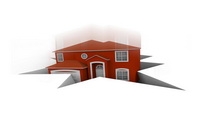Advertisement
Homeownership Rates Revert Back to Levels of Last Decade

The drop in the homeownership rate from an all-time high of 69.2 percent in 2004 to 66.4 percent in the first quarter of 2011 reflects a decline from unsustainable levels to something closer to historical averages, according to a study from the Mortgage Bankers Association (MBA's) Research Institute for Housing America (RIHA). While the homeownership rate may have bottomed out, it could fall another one or two percentage points because of tightened credit and other factors, the paper says.
Titled "Homeownership Boom and Bust 2000 to 2009: Where Will the Homeownership Rate Go from Here?," the study was conducted by professors Stuart Gabriel of UCLA's Anderson School and Stuart Rosenthal of Syracuse University. They found that the increase in the homeownership rate in the middle of the last decade extended to all age groups, but was most pronounced among individuals under age 30. These increases coincided with looser credit conditions that enhanced household access to mortgage credit, along with less risk-averse attitudes toward investment in homeownership. Following the crash, these trends have reversed and homeownership rates have largely reverted to the levels of 2000.
"The question of why homeownership rates are falling now is really a question of why they were so high during the middle of the last decade," said Gabriel. "From the late 1960s to the mid-1990s, U.S. homeownership rates were relatively stable between 64 and 65 percent. Our findings suggest that the boom and bust in homeownership rates over the last decade was driven in part by an initial relaxation of credit standards followed by a tightening of credit with the onset of the 2007 financial crash. Evidence also suggests that households led by those in their 20s and 30s were willing to take more risk with respect to homeownership in the boom years, followed by a return to a more conservative approach after the crash."
Key findings from the study include:
►A combination of changes in mortgage credit standards and attitudes towards investment in homeownership likely contributed to much of the boom and bust in homeownership over the decade. As credit conditions loosened in the first part of the decade, many people of all ages who would have remained renters instead became homeowners. With the financial crash, the recession, and tighter credit conditions, homeownership rates have fallen back to levels close to those of 2000 for most age groups.
►Changes in the population's socio-demographic composition and economic attributes also served to lower homeownership rates between 2000 and 2009. For all household heads age 20 to 80, demographic-socioeconomic shifts pushed homeownership rates down by roughly two additional percentage points over the period. These effects were notably different across demographic groups, however. For example, among individuals 25-35 years old, shifts in their demographic-socioeconomic attributes pushed homeownership rates down by nearly five percentage points over the 2000-2009 period. For African Americans the analogous value was only roughly one percentage point.
►Individuals appear to have been more risk-seeking in their approach to home buying in the first half of the last decade. This changed to a more risk-averse posture following the real estate meltdown.
►Between 2000 and 2009 there was a one percentage point increase in the homeownership rate. But, were it not for the shifts in access to homeownership through easier credit and the changes in socioeconomic conditions, the homeownership rate would have actually fallen between 2000 and 2005, rather than increasing.
"Homeownership is deeply embedded in American culture and long has been a symbol of economic achievement in the United States. The recent sharp decline in the homeownership rate has symbolic as well as tangible adverse effects on the economy, with home sales and construction activity remaining near all-time lows," said Michael Fratantoni, executive director of RIHA and MBA's VP of research and economics. "This is another in a series of studies that RIHA has issued on the issues of household formation, borrower attitudes after the recession and homeownership. Single- and multifamily lenders, other participants in the real estate finance industry, and policymakers can utilize this research and assumptions on homebuyer behavior and credit availability to form their own forecasts regarding the likely path of the homeownership rate and implications for the mortgage market going forward."
The study relies on individual-level data from the 2000 census and the 2005 and 2009 American Community Surveys (ACS) to assess housing choice and uses 34 control variables to analyze the underlying drivers of homeownership. The paper is divided into three parts: An assessment of the underlying drivers of homeownership, an ex-post analysis of the boom and bust in homeownership during the 2000s, and a discussion of what may lie ahead for U.S. homeownership rates.
About the author





